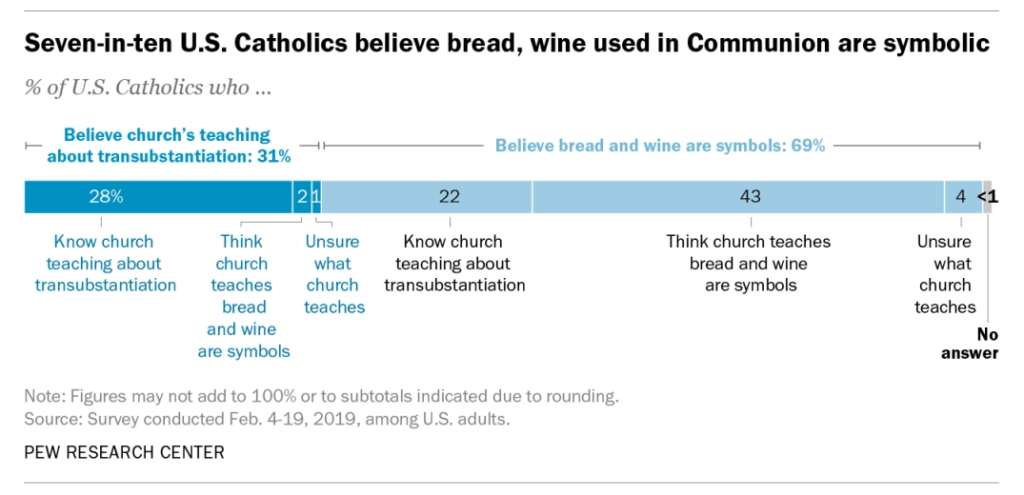Getting Vaccinated In An Unstructured World
It’s a late thursday night of the day I spent an hour sitting in a doctor’s office to get vaccinated, then observed afterwards. I am exhausted. My arm is killing me. I feel weird in the stomach, and my eyes hurt. None of this relates to the vaccine, as best I can tell, by the way. I’m exhausted because I’ve been working all day, then I had to arrange transport to the doctor’s, then get home, and then, I had to work on rebuilding my bed, because that can’t really wait. It meant that after getting the vaccine — which was convenient and easy and even literally painless — I came homje and had a list of things I had to do before I could tell myself I had the freedom to relax.

And then, eventually, that opportunity arrived, and I had a shower.
Continue Reading →The Eucharist Wafer Conspiracy
Who doesn’t love a good Catholic conspiracy theory?
Not one of the conspiracy theories the Catholics have used to shape the way the world views faith and itself, no, those tend to be a bit more… well, they’re the conspiracy theories that we think of as ‘conspiracy theories,’ and they almost all seem to trace back to someone saying ‘Well, Martin Luther was wrong about a lot of things, but as far as it goes on the jews.’
And this isn’t one of those Protestant conspiracy theories about Catholics, which range from ‘they put cornflakes in their bed to stop masturbating’ (kinda true) to ‘they can’t whistle or the pope will hear,’ (definitely not true). It’s about eucharist wafers, and it’s about a conspiracy that, seemingly, some Catholics seem to think exists despite not believing in it.

The Eucharist wafer, if you’re not familiar, is a small bit of more-or-less bread used in a ritual known as the eucharist. During the Biblical narrative of the last supper, a ceremony we mostly document from the one person who definitely makes it clear he was not there, Jesus gives a speech where he offers the disciples wine and bread, saying, and I paraphrase, ‘Come, eat of this, for it is my body and blood, eat it in remembrance of me.’ It’s something Protestants and Catholics share as a ritual.
It is, however, supremely weird.
It’s really one of the sources of dissent between Protestants and Catholics – there’s an idea that this ritual, along with the baptism of infants, was basically one of the things that got the ball rolling on all the schisming and that’s why one of the major groups of not-Catholic Christians that hate the Catholics a lot (except when they’re trying to leverage them for political power) are known as ‘Baptists.’
The weird ritual is a little weirder in Catholic circles because of a belief known as transubstantiation. This idea is that the eucharist, when consumed, literally transforms into actual real Jesus meat and actual real Jesus blood. This belief was used to claim that Catholics were cannibals and tie them to blood libel (and what the hey, we’re back at the Jewish stuff again, that’s weird and sucks).
Transubstantiation is contentious because this idea, that the wafer and wine become real blood and meat is actual Church doctrine. That’s like, inasmuch as there are rules on this stuff, that’s what the rulebook as written says is there. The consensus amongst Catholics in the United States is, however, that this isn’t true; about two thirds of Catholics think that it’s entirely symbolic, just under one third believe it’s not. The church says it’s true, most people don’t believe it.
This makes it an interesting question to ask about on forms, and that gave us this beautiful graph from August 2019.

In this graph, we see that 69% of people (nice) don’t believe that the eucharist becomes real god meat. 31% believe it does. But there’s a breakdown in that; of the 69% of catholics who think that the bread and wine are symbolic, about two thirds of them think that the church also teaches that the wine and bread are symbols. This means that of the entire cohort, almost 45% of Catholics think that the bread and wine are symbolic, which is incorrect, according to the Catholic church itself.
Here, though, is where it gets wonderfully weird.
There is a cohort of 31% that believe that the food they are eating is magically transformed into god meat and blood. This is made up of a body (hah) of around 14 million Catholics, who believe in transubstantiation and who also believe that the church teaches transubstantiation. Yet next to them, in that weird little sliver, is that 2% that believe that it does become god meat… but that the church teaches it doesn’t.
What the heck.
What do they think happens there?
It’s this beautiful little bubble. How do you believe in a core point of doctrine for your church while believing they don’t agree with you, while also believing the weirder thing. Believing that you are secretly transubstantiating with a ritual performed by a priest who you also think is not doing the thing required for transubstantiation to happen, but you’re somehow bootlegging Jesus Bacon into your system some other way?
A little secret community of roughly a million Catholics in the United States.
Weird, huh?
So Russia Was A Thing That Happened, Huh
Content warning: I’m going to talk a brief bit about the Q conspiracy, and US Politics, particularly 2016 and the 45th president of the United States!
Continue Reading →Every Church Has A Conspiracy Theory
Qanon has been a surprising opportunity for a lot of people to learn something they probably never realised before: That the conspiracy theory wing of the world was bountifully alive, well, and extremely well-fed, in the existing landscape of Christian dominionism.
Content Warning: Church, Qanon and related subjects, American Christianity, and Conspiracy Theories.
Continue Reading →The Human Mars Base That Definitely Exists I Promise Dude Just Trust Me
Hey, you remember me mentioning the Giant of Kandahar? That was a fun bit of conspiratorial nonsense embraced by bad people in an existing support network of fabulist grifters and true believers, wasn’t it? It was especially fun because, if it’s true (and you can’t prove it’s not!) then you’re left with proof that conspiracies are true, and that means you may believe in other conspiracies, because, after all, the coverup of the Giant of Kandahar shows it!
Gunna talk about conspiracy theories, which are fun, but then I’m going to talk about Qanon, which isn’t! I guess I’m also mean to the Seven Day Adventists a little?
Continue Reading →The Johnlock Conspiracy Conspiracy
First of all this is going to be building off a point first cast into relief for me by Sarah Z’s video on The Johnlock Conspiracy. She is both directly connected with the experience of this space and did the research into the actual history of the people involved, a sort of on-the-spot observer recounting her experiences ethnographically. If you want a longer form deep dive on what The Johnlock Conspiracy is, check out that video. I will be providing a quick summary.
I’m also going to talk about fanagement, which I wrote about last year, which is about the way that fan engagement was seen as being a thing that corporate entities could deliberately engage for commercial ends. Fanagement isn’t necessarily an inherently evil or corrupting thing, but it’s something to know about as something that exists, and knowing it exists can colour your relationship to the media created in response to fanagement.

The Giant of Kandahar
When you talk about conspiracy theories, or false information, one of the unfortunate side effects, because of how our brain processes information, is that outlining the thing first creates the impression that it’s true, and then the disproving has to be satisfactory to that. Even if you do a perfect job debunking the introduced idea, our memories filter away in different order, and the thing more easily brought to mind seems more true. It means you have to be careful how you introduce the outlandish, for fear of leaving people with the impression of the wrong thing having a kernel of truth.
With that in mind, there’s a not insignificant number of people who believe the United States government found a giant in the invasion of Afghanistan and are covering it up.
Pause for effect.
Continue Reading →Sheith!
Y’know, I’m not actually big on shipping Sheith.
This isn’t because it’s a bad ship or nothing. It’s —
You know what, let’s be really quick here for the normals that might wind up reading this. Shipping, which started with the Starsky and Hutch fandom in the 1970s, is the idea of members of a fandom pairing two characters together in a (usually sexual) relationship. This usually, but not always, serves as the basis for some kind of creative media outside the series or book or story that explore or express that.
So you know, if you watch say, Power Rangers and hope that the pink ranger winds up with the blue ranger instead of with the green ranger (and ho boy do I have some news for you on that front) you are, in that time, ‘shipping’ those characters in your mind. If you want to talk about that pairing, you’d refer to that pairing as a ship; ‘the pink ranger/blue ranger ship.’
This is pretty normal and you’ll find lots of people do this even if they don’t necessarily think of it as an activity with a name. You could look at the long-term predictions about relationships people made about Game of Thrones as a sort of massive mainstream shipping incident.
Continue Reading →The Bright Conspiracy Theory
Okay, hold up.
I don’t want you going to think this is true. This is a hunch. This is a notion.
I want you to understand I don’t like holding hypothesis that can’t be easily proven. I grew up around conspiracy theorists, and I feel like I can recognise the mental habits that make a conspiracy. Conspiracies rely on being nebulous, unfalsifiable and emotionally satisfying. That is, they want to attribute blame to an unknowable ‘them,’ they can’t be shown to be wrong somehow, and they feed into emotional responses we already have.
Furthermore, I haven’t seen the Netflix movie Bright. I’ve seen its advertising, and that convinced me that Bright sucks and I don’t want to watch it, which in a reasonable world would be a good sign that the advertisers were good at their job, but that’s not how advertising is advocated as working in this mixed up ole world of ours.
With those clauses in mind, the actual quality of Bright and if you liked it, is really moot.
Instead, I want to talk to you about how and why Bright gets talked about at all.
The Rural Purge
In Understanding Media (1964), Marshall McLuahn refers to America as a culture where
the death of all the salesmen at one stroke of the TV axe has turned the hot American culture into a cool one that is quite unacquainted with itself.
Now, I think that he’s wrong, because hey. Disagreeing with McLuahn in general is kind of how you get started in media studies, even as you recognise the dude was right about a lot of stuff. Still I think he’s wrong in the idea that TV, in the 1960s, represented the death of salesmen (because sales and advertising are very different creatures).
The Strange Antisemitism Of The Pro-Israel Fundamentalists
Hey! Gunna talk about Jews! And Fundamentalism! And I even mention the KKK! Maybe wanna jump out if you’re not into hearing me talk about that.
Continue Reading →Arkaeology
Now look, I need some disclaimers up front. First and foremost, you are hearing twenty-year old memories that were encoded, at the time, by an eight year old. Second, I was at the time, a second-hand source. I did not see the events, I saw the news reporting on the event, I saw my family talking about it, and eventually, spoke to the person in question. With that disclaimer in the way, let’s talk about one of the more goofy parts of my childhood, the persistent presence of Arkaeology.
Continue Reading →From Inside The Bubble
I’ve mentioned the Christian media bubble I grew up in, this little landscape of carefully controlled worldview. It’s conspiracy theory garbage, and unfortunately, a lot of people in the real world live in it. But while I’ve made hay out of the replacement media, the ‘Christian Versions’ of things we were given to replace the higher-quality, less-Christian versions of same, I don’t think I’ve ever mentioned the strangeness that was the times we tried to claim something from outside the bubble.
Now, my dad was not a purist for the bubble. Broadly speaking, he does not believe it’s that which goes into a man but that which comes out of him that corrupts him, ignoring exactly what the context of that sentence was saying in the Bible. It’s still an interesting perspective, which means that my dad read Harry Chapin lyrics from the pulpit confident in the knowledge that nobody in the congregation would know he was quoting a popular songer.
There were others, however, who liked things outside the bubble, who would argue for the Christian-ness of things that they brought in. Age worked in their favour in a lot of ways; both older people and older media were usually more wholesome. John Wayne movies, for example. I saw True Grit and it was okay, even though it had a swear. There were some… edge cases though.
See, one of the ideas we really clung to in these environments was the christian as an oppressed minority. We were sure that there weren’t that many Christians in the world (so missionary work was always important), and that we had almost no power. Hollywood was a vast, christian-eating machine and we warned people to stay away, or if they must go, go knowing they would be hated. Therefore, any ‘big’ media we could attribute as Christian was the result of some clever, insidious trickery on the part of a covert operative Christian, sneaking up the villainous Hollywood’s tower and waving a tiny Christian flag, reminding us all to stay strong.
I’m not kidding.
The first one to stick in my head was Enemy of the State, a conspiracy movie from the late 90s which focused on Will Smith as a hapless victim in a government conspiracy carrying information that was dangerous for someone. I saw it in theatres and heard, a few nights later, a member of the congregation argue that it was a good movie, as it was clearly trying to demonstrate the government of the End Times. It was, they said, a movie that was made for post-Rapture Christians (people who convert after the rest of us leave town), to be prepared for and understand the world they were going to live in. The main thing I remembered in the movie was the lingerie store scene.
The second movie was The Matrix, which we went and saw as a Youth Group because of course we did. See in this movie, there were Bible words, and there was Trinity and that meant that we were clearly seeing a covert missive from our Christian brothers (and sisters I suppose) in Hollywood who had made this movie. We read into the metaphors of this movie convinced that the Nebuchadnezzer was a reference to timescales, that there was some prophetic divination that we could untether in our little youth study classes. Just imagine a youth minister saying, ‘Much like Neo, in the Matrix, Jesus-‘ and you have the image of what happened.
Now I want to make it clear, if you’re a Christian, if you espouse this faith, that’s fine. And I think if you do, you might be a bit insulted to think that the Matrix movies were made for you by a secretive conspiracy and not, as they probably were, created as a sci-fi anime mishmash by a trans woman and her brother, with references to thousands of different sources in cinema and literature. Find your Christian reading, sure, but claiming it was made to be a Christian movie is…
Let me just settle on ‘weird.’
The third one, though, the third one was a movie I loved. That was The Transformers movie. How did we know the secret of that one? What gave away the secretive Christian nature of this piece of toy advertising? Was it the death-rebirth cycle of Primes? Was it the Matrix of leadership and the martyrdom and resurrection of Ultra Magnus? Perhaps it was the way the Junkions fought and did not become tired. Nope, nope, nope. The reference to Judas that was Starscream?
No.
No, the thing that tipped off the church member arguing for this was that in the opening of the movie, Hot Rod runs over a barricade guarded by Kup.
His Kup Runneth Over.
I saw an adult make that argument with a straight face.
Anonymous and Stonewall
Roland Emmerich is not a name I really associate with greatness. I get that for some people he’s the shit and Independence Day is untouchable but broadly speaking, every time I hear his name it’s with, at best, a sigh. Roland Emmerich’s being talked about right now because of Stonewall.
I figured Stonewall would be a piece of oscar-baiting bullshit designed to let the Media Capital Hollywood tell itself that it was, in fact, a progressive and liberal bastion, because Feeling Liberal is Hollywood’s conservatism. It was the kind of movie when I heard it was going to be made where I was 100% certain that it would be handled badly. I didn’t know specifics – I was not at the time super well versed in the history of the Stonewall Riots and I rarely go in for betting on things. But I was pretty sure that there’d be a tan pale-haired white gay dude very, very important to the centre of the story.
Mostly, this has been my expectation ever since I learned about Anonymous.
Anonymous is a conspiracy theory film presented as if it’s a historical narrative in which one of the most important artists of European storytelling, a creator of forms and words, was not, in fact, that rye-trading commoner William Shakespeare but was, instead, a white-haired slightly effeminate noble man of wealth, breeding and education.
I’m not really sure how to convey this, but it’s something that’s stuck in my head every time that white-haired gay noble man of wealth, breeding and education that is Roland Emmerich comes up. Especially when we’re talking about stories that seem to centre around issues of creativity or gay rights. What I’m saying is that broadly speaking, from what I’ve seen, Roland Emmerich is the kind of artist who can’t abide the idea that important things aren’t about him.
This is a pretty common affliction for white dudes.